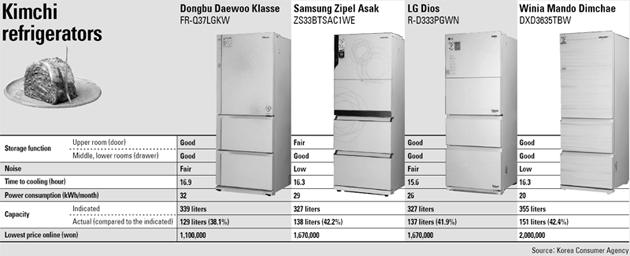Battle of the kimchi refrigerators

As kimchi-making season reaches its end, the Korea Consumer Agency (KCA) reviewed this year’s four most popular models from each major home appliance brand.
The study, unveiled Monday, compared four standing refrigerators of 300-liter capacity: Samsung Electronics’ Zipel Asak, LG Electronics’ Dios, Winia Mando’s Dimchae and Dongbu Daewoo Electronics’ Klasse.
“All four refrigerators we tested had an actual capacity of only 40 percent of indicated capacity,” said the consumer agency.
The KCA explained that the refrigerators were designed to leave only 129 liters (34 gallons) to 151 liters out of 300 for kimchi containers, because they prepared space for other food items such as meat, dairy products, eggs and drinks.
“It is rare to find consumers who purchase a kimchi refrigerator to store only kimchi,” said an industry source. He explained that standing kimchi fridges were developed after consumers complained that “older [kimchi] fridges, which open from the top, made it difficult to store other foods because users have to take out every item when pulling out a kimchi container at the bottom.”
According to the agency, the distribution of kimchi fridges in Korea has surpassed that of air-conditioners and generates more than 2,000 complaints of damages each year.
The agency plans to submit a proposal to the Korean Agency for Technology and Standards to require that home appliances companies must indicate the refrigerators’ capacities specifically for kimchi containers.
In the test, Dios, Dimchae and Klasse received good marks in storage performance, the most significant function. Temperatures of upper storage, closed with hinged doors, and lower storage drawers showed little difference compared with the preset temperature. Samsung’s Zipel Asak was the only product that received lower points due to temperature variance.
Zipel outperformed other brands in noise level measured 1 meter (3.2 feet) away from the refrigerator when cooling function was set on strong.
LG’s Dios showed the fastest cooling ability and Dongbu Daewoo’s Klasse was the slowest.
To assess each fridge’s capacity in keeping kimchi fresh for a long period of time, the agency test-filled 70 percent of storage containers with salted water and measured the time it took to cool from 20 to 5 degrees Celsius (68 to 41 degrees Fahrenheit).
Winia Mando’s Dimchae received good ratings in most performance tests such as temperature, noise, electricity consumption and storage capacity. In particular, Dimchae was the only product to have been certified by Korea Energy Management Corporation’s Energy Efficiency Standardization and Certification Center, for which Zipel Asak and Dios received second class and Klasse third class ratings. The least efficient model was estimated to result in power bills up to 1.6 times larger than the most efficient.
Although Dimchae was selected as the most efficient, the fridge body price was nearly 1.8 times more expensive than Klasse.
Dios had the widest variety of additional features, such as a small separate door that allows removal of frequently used ingredients, a partial power-off button that also saves energy, an alarm that warns when the door is open for too long and deodorization of all areas. For the best performance and energy efficiency, the agency advised consumers to install the kimchi fridge indoors, where temperature is steady, and at least 10 centimeters (3.94 inches) from the wall.
BY KOO HEE-RYEONG [jiyoon.kim@joongang.co.kr]










with the Korea JoongAng Daily
To write comments, please log in to one of the accounts.
Standards Board Policy (0/250자)